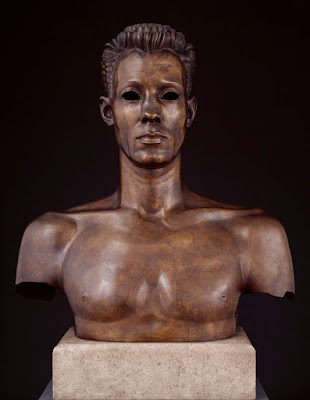 |
| William Orpen Le Chef de l'Hotel Chatham, Paris ca. 1921 oil on canvas (diploma work) Royal Academy of Arts, London |
"The painting depicts Eugene Grossrieter, called Chester, second chef at the Hotel Chatham in Paris. Orpen painted him with a swagger and authority ultimately derived from Manet via Velázquez. This treatment, formerly reserved for the great and powerful, carries an extra charge as applied to a working man."
 |
| Glyn Philpot A Young Man ca. 1921 oil on canvas (diploma work) Royal Academy of Arts, London |
 |
| Charles Haslewood Shannon Vanity and Sanctity 1921 oil on canvas (diploma work) Royal Academy of Arts, London |
 |
| Arthur J. Davis Design for Westminster Bank, Threadneedle Street, London 1921 drawing (diploma work) Royal Academy of Arts, London |
 |
| George Harcourt Portrait of Miss Anne Harcourt 1921 oil on canvas (diploma work) Royal Academy of Arts, London |
 |
| Richard Jack On the Moors 1921 oil on canvas (diploma work) Royal Academy of Arts, London |
 |
| Eric Kennington Abd-el-Rahman 1921 pastel on paper (diploma work) Royal Academy of Arts, London |
"This portrait was produced as one of the original illustrations to T.E. Lawrence's Seven Pillars of Wisdom. Bad el Rahman is mentioned in the book as 'a runaway slave from Riadh, now freedman of Mohammed el Dheilan, the Toweihi.' Commissioned by Lawrence, Eric Kennington travelled to the Middle East (albeit at his own expense) where he located and drew many of the individuals mentioned in the memoir."
 |
| Giles Gilbert Scott Design for Cathedral Church of Christ, Liverpool 1922 drawing,with added watercolor (diploma work) Royal Academy of Arts, London |
 |
| Bertram Priestman Near Wareham, Dorset 1923 oil on canvas (diploma work) Royal Academy of Arts, London |
 |
| Maurice Greiffenhagen The Message 1923 oil on canvas (diploma work) Royal Academy of Arts, London |
 |
| Thomas Monnington Piediluco ca. 1923 oil on panel (diploma work) Royal Academy of Arts, London |
 |
| Melton Fisher Winifred 1924 oil on canvas (diploma work) Royal Academy of Arts, London |
 |
| Philip Connard Apollo and Daphne 1925 oil on canvas (diploma work) Royal Academy of Arts, London |
"Philip Connard, Keeper of the Royal Academy between 1945 and 1949, was sympathetic to the anti-modernist stance of then-President of the Royal Academy, Sir Alfred Munnings. The world of Connard's 1920s paintings such as Apollo and Daphne is lush, sometimes idyllic, and profoundly untouched by modernity and its discontents."
 |
| Guy Dawber Design for Ashley Chase, Dorset ca. 1925 drawing, with added watercolor and gouache (diploma work) Royal Academy of Arts, London |
 |
| Alfred Hardiman Study of a Scientist 1925 bronze (diploma work) Royal Academy of Arts, London |
"Saying he wanted to make a masterpiece, Alfred Hardiman spent several hours every week for a year sculpting zoologist Maurice Burton in clay, before casting the bust in bronze. Burton, a sponge specialist at the Natural History Museum, was surprised when Hardiman suggested he had a 'sculpturesque' face. "At the age of ten I had had my nose broken, flattened across my face . . . since then any remarks about my physiognomy had been unanimously unflattering." In his unpublished autobiography Dr Burton recalled meeting Hardiman and sitting for the bust: "It was one of those days that stays vividly impressed on the memory: a day of late summer, of brilliant sunshine. We had played tennis throughout the afternoon and into the evening, when the light faded and we adjourned to the Hardiman's house, to end the day with table tennis and billiards. Alfred had jet-black hair, an aquiline nose and piercing dark eyes. His face as a whole had the aspect of a bird of prey. Whether I was playing tennis or billiards I was constantly aware that he was watching me intently and when the time came to say our 'Goodnights' he buttonholed me with the words: 'Would you be agreeable to sitting for a bust for me?' Somewhat embarrassed, I replied: 'I would be honoured.' There was no need for the bust to talk since sculptor and sitter were seldom silent for more than a few minutes on end. To add to this, it seems Alfred had discovered not only that I was a good sitter but I also had a good torso. So bits of me were used for several other sculptures he was working on concurrently with the bust."
– quoted texts adapted from Royal Academy notes